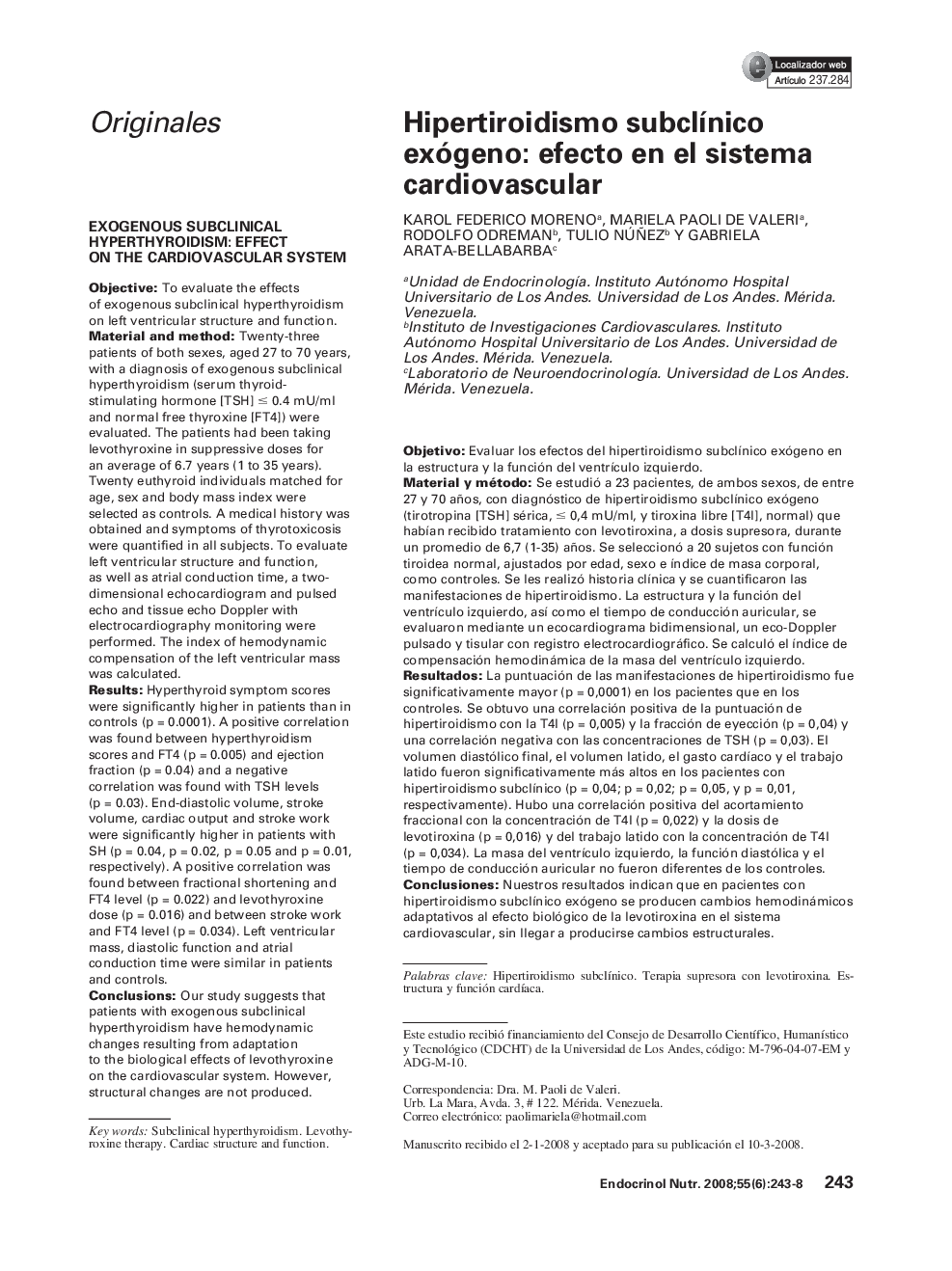| کد مقاله | کد نشریه | سال انتشار | مقاله انگلیسی | نسخه تمام متن |
|---|---|---|---|---|
| 2774605 | 1152229 | 2008 | 6 صفحه PDF | دانلود رایگان |

ObjetivoEvaluar los efectos del hipertiroidismo subclínico exógeno en la estructura y la función del ventrículo izquierdo.Material y métodoSe estudió a 23 pacientes, de ambos sexos, de entre 27 y 70 años, con diagnóstico de hipertiroidismo subclínico exógeno (tirotropina [TSH] sérica, ≤ 0,4 mU/ml,y tiroxina libre [T4l], normal) que habían recibido tratamiento con levotiroxina, a dosis supresora, durante un promedio de 6,7 (1-35) años. Se seleccionó a 20 sujetos con función tiroidea normal, ajustados por edad, sexo e índice de masa corporal, como controles. Se les realizó historia clínica y se cuantificaron las manifestaciones de hipertiroidismo. La estructura y la función del ventrículo izquierdo, así como el tiempo de conducción auricular, se evaluaron mediante un ecocardiograma bidimensional, un eco-Doppler pulsado y tisular con registro electrocardiográfico. Se calculó el índice de compensación hemodinámica de la masa del ventrículo izquierdo.ResultadosLa puntuación de las manifestaciones de hipertiroidismo fue significativamente mayor (p = 0,0001) en los pacientes que en los controles. Se obtuvo una correlación positiva de la puntuación de hipertiroidismo con la T4l (p = 0,005) y la fracción de eyección (p = 0,04) y una correlación negativa con las concentraciones de TSH (p = 0,03). El volumen diastólico final, el volumen latido, el gasto cardíaco y el trabajo latido fueron significativamente más altos en los pacientes con hipertiroidismo subclínico (p = 0,04; p = 0,02; p = 0,05, y p = 0,01, respectivamente). Hubo una correlación positiva del acortamiento fraccional con la concentración de T4l (p = 0,022) y la dosis de levotiroxina (p = 0,016) y del trabajo latido con la concentración de T4l (p = 0,034). La masa del ventrículo izquierdo, la función diastólica y el tiempo de conducción auricular no fueron diferentes de los controles.ConclusionesNuestros resultados indican que en pacientes con hipertiroidismo subclínico exógeno se producen cambios hemodinámicos adaptativos al efecto biológico de la levotiroxina en el sistema cardiovascular, sin llegar a producirse cambios estructurales.
ObjectiveTo evaluate the effects of exogenous subclinical hyperthyroidism on left ventricular structure and function.Material and methodTwenty-three patients of both sexes, aged 27 to 70 years, with a diagnosis of exogenous subclinical hyperthyroidism (serum thyroid-stimulating hormone [TSH] ≤ 0.4 mU/ml and normal free thyroxine [FT4]) were evaluated. The patients had been taking levothyroxine in suppressive doses for an average of 6.7 years (1 to 35 years). Twenty euthyroid individuals matched for age, sex and body mass index were selected as controls. A medical history was obtained and symptoms of thyrotoxicosis were quantified in all subjects. To evaluate left ventricular structure and function, as well as atrial conduction time, a two-dimensional echocardiogram and pulsed echo and tissue echo Doppler with electrocardiography monitoring were performed. The index of hemodynamic compensation of the left ventricular mass was calculated.ResultsHyperthyroid symptom scores were significantly higher in patients than in controls (p = 0.0001). A positive correlation was found between hyperthyroidism scores and FT4 (p = 0.005) and ejection fraction (p = 0.04) and a negative correlation was found with TSH levels (p = 0.03). End-diastolic volume, stroke volume, cardiac output and stroke work were significantly higher in patients with SH (p = 0.04, p = 0.02, p = 0.05 and p = 0.01, respectively). A positive correlation was found between fractional shortening and FT4 level (p = 0.022) and levothyroxine dose (p = 0.016) and between stroke work and FT4 level (p = 0.034). Left ventricular mass, diastolic function and atrial conduction time were similar in patients and controls.ConclusionsOur study suggests that patients with exogenous subclinical hyperthyroidism have hemodynamic changes resulting from adaptation to the biological effects of levothyroxine on the cardiovascular system. However, structural changes are not produced.
Journal: Endocrinología y Nutrición - Volume 55, Issue 6, June 2008, Pages 243–248